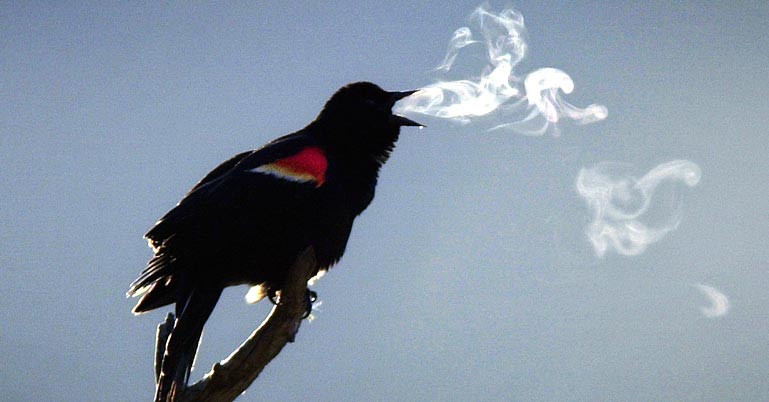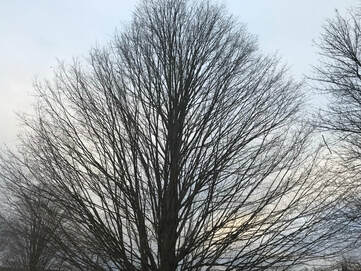 (c) Boston Globe (c) Boston Globe With temperatures in the New York City area in the single digits and teens over the past few days, a stroll outside can feel like an adventure. One of the more noticeable things about walking outside on a chilly day is that we can see our breath. With every exhale, a small cloud billows from our mouth, wisps whirling, clustering, separating and then fading into the surrounding air. From each living, breathing animal-being around us, cloudlets emanate with every breath, vaporous chiaroscuro intermingling with the exhales of passers by, as if engaging in a collective dance. Dogs on their outings and birds too display visible breath. Even the exhaust from cars and output from the tall chimney stacks on buildings become more visible, suggesting that in way they too are breathing, or that perhaps we living creatures have our own little engines. Indeed it is the oxygen we breathe in that fuels our bodies. We can live a month without food, a week without water, but only a few minutes without oxygen. Seeing our breath on a cold day is a reminder of our reciprocity with the natural world around us. The air we take in is 21% oxygen (78% is nitrogen) because of plants, which intake carbon dioxide and mix it with sunshine to create sugar and breathe out oxygen. We are taught in meditation to focus on our breath. How much easier it is to focus on breath when it becomes visible. And how much it reminds us of this minute by minute bodily process -- on average 16 breaths per minute -- that sustains our lives and the lives of others creatures around us.
1 Comment
 As we honor Dr. Martin Luther King Jr. and reflect on the Civil Rights movement of the 1950s and 60s as well as issues of racial justice and equality that need attention today, we also have an opportunity to consider how the values underpinning civil rights apply not only among people -- across race, ethnicity, gender, class, sexual orientation, age, disability, and religion -- but also to our relationship with nature. Fundamental to civil rights is a moral attitude of respect, compassion, appreciation for one another's inherent, integral worth, and a sense of community, interconnectedness, and interdependence. The same ethos applied to our relationship with nature -- a perspective proffered by a number of writers, artists, poets, environmentalists and philosophers, and embedded in many religious practices and indigenous cultures -- would radically transform how we engage with the natural world. It would alter how we organize our business, social, and political conventions in connection with nature, from resource extraction, conservation, pollution management, and energy development, to how we choose to engage our leisure time, to how we design our homes and communities. And in turn, by altering tendencies to objectify inhabitants of the living world around, cultivating respect for nature likely would also enhance our respect for other humans. We abuse land because we regard it as a commodity belonging to us. When we see land as a community to which we belong, we may begin to use it with love and respect.” ― Aldo Leopold  The Central Park Lake The Central Park Lake With a number of days of below-freezing temperatures, ponds in the New York City area are beginning to ice over. Water that just a week ago responded to the subtlest of breezes begins to harden and solidify. The freezing starts on the edges of the pond, where the water is shallow, and crystallizes into a choreography of frozen formations: varying patterns and textures, spindle-like, smooth and pristine, rough and abraded, rivulets and cracks. The ice encases fallen leaves and twigs, a cryogenic embalming that delays their decomposition until the spring thaw. Infinite small bubbles gather below the frozen surface, and peering down through the ice at these glistening spheres seems not unlike gazing through a glass window at the starry night sky. They form a Milky-Way in aqueous suspension. Over the coming weeks, assuming the temperature frequents below freezing, the ice will grow toward the ponds' center, until the entire pond is frozen over. This icy sheath, H20 in its solid state, will separate the liquid world below, the realm of hibernating fish, turtles, and aquatic frogs, from the air above containing water in a gaseous state, including the moisture of our own breath, cloud-like and visible, and comingling with the chilly winter air.  One of the blessings of winter is the opportunity to observe the architecture of hardwood trees. Shorn of concealing leaves, their framework becomes visible -- fractal geometry, with branches splitting off and again dividing and splitting, from the thick central trunk, a torso of sorts, culminating in finer twigs, like small fingers, reaching outward and upward. Each type of tree displays unique morphology and growth patterns, with limbs branching off at wider or narrower angles, sometimes looping downward in a "u" shape before ascending, some knobby, gnarled and twisted, others soaring, erect, and tapering, some with great symmetry, others more variable -- a range of templates for achieving growth and access to nourishing sunlight. The texture of trees' bark becomes more apparent in the crisp light of winter, the furrowed, patterned grooves of elms appear in greater relief, the smooth, silvery surface of beeches almost shines, and one senses the tactile feel of the scaly, thinly-plated bark of London Plane trees. Knots, burls, fissures, and cavities become visible. And amid the the muted winter palette, one can discern bark's varying colors, ranges of browns, grays, white, and green, sometimes with tinges of orange or red, colors often overshadowed by inviting greens and flamboyant autumn shades in the year's other seasons. And then there is the experience of striding past a stand of denuded trees, their trunks tall and aligned, like sentinels. With each step, a movement felt more keenly horizontal in relation to the trees' verticality, one's perspective changes and the trees relative alignment with one another alters, with cinemographic and near-kaleidoscopic effect. Perhaps winter hardwoods offer a metaphor as we embark on a new year: unadorned, the trees exhibit their underlying stark beauty, strength and symmetry. All is apparent, nothing is concealed. Yet, even in this state, small buds are visible, waiting for the right conditions to bloom and flourish. "I prefer winter and fall, when you feel the bone structure of the landscape. Something waits beneath it; the whole story doesn't show." -- Andrew Wyeth |
About this Blog
Hi! I'm Nancy Kopans, founder of Urban Edge Forest Therapy. Join me on an adventure to discover creative ways to connect with nature in your daily life, ways that are inspired by urban surroundings that can reveal unexpected beauty, with the potential to ignite a sense of wonder. Archives
April 2023
Categories
All
|

 RSS Feed
RSS Feed